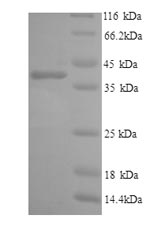The 6xHis gene is tagged to the gene fragment encoding the 20-365aa of the human IL6 receptor subunit alpha (CD126) to obtain the target gene. The target gene is then amplified via PCR and inserted into expression vectors to create recombinant plasmids. These plasmids are introduced into yeast cells, which are subsequently cultured to express the CD126 protein. Following cultivation, the supernatant is collected and purified using affinity chromatography, producing recombinant human CD126 protein with a purity level exceeding 90% as verified by SDS-PAGE.
Human CD126, also known as IL-6Rα, along with CD130, binds to IL-6, initiating a cascade of intracellular signaling vital for various physiological processes, including immune response, inflammation, and hematopoiesis [1][2]. CD126 is primarily expressed on a variety of cell types, including B cells, T cells, and certain epithelial and hepatocyte cells [3][4]. Its expression is crucial for the activation and differentiation of immune cells, particularly in the context of inflammatory responses. CD126 is involved in the differentiation of Tregs and can influence their suppressive functions [5][6]. The presence of CD126 on Tregs is associated with their ability to respond to IL-6, which can modulate their activity and stability under inflammatory conditions [7].
References:
[1] N. Aziz, Relationship among serum levels of il-6, sil-6r, s gp130 and cd126 on t-cell in hiv-1 infected and uninfected men participating in the los angeles multi-center aids cohort study, Plos One, vol. 18, no. 10, p. e0290702, 2023. https://doi.org/10.1371/journal.pone.0290702
[2] M. Murakami, D. Kamimura, & T. Hirano, Pleiotropy and specificity: insights from the interleukin 6 family of cytokines, Immunity, vol. 50, no. 4, p. 812-831, 2019. https://doi.org/10.1016/j.immuni.2019.03.027
[3] A. Mishra, I. Kemler, & D. Dingli, Preclinical development of cd126 car-t cells with broad antitumor activity, Blood Cancer Journal, vol. 11, no. 1, 2021. https://doi.org/10.1038/s41408-020-00405-z
[4] F. Liu, J. Li, P. Wang, T. Farren, H. Li, X. Hao, et al., Cd126 and targeted therapy with tocilizumab in chronic lymphocytic leukemia, Clinical Cancer Research, vol. 22, no. 10, p. 2462-2469, 2016. https://doi.org/10.1158/1078-0432.ccr-15-1139
[5] L. Zeebroeck, R. Hornero, B. Côrte-R, eal, I. Hamad, T. Meißner, & M. Kleinewietfeld, Fast and efficient genome editing of human foxp3+ regulatory t cells, Frontiers in Immunology, vol. 12, 2021. https://doi.org/10.3389/fimmu.2021.655122
[6] Y. Chen, Z. Xu, R. Liang, J. Wang, A. Xu, N. Na, et al., Cd4+cd126low/− foxp3+ cell population represents a superior subset of regulatory t cells in treating autoimmune diseases, Molecular Therapy, vol. 28, no. 11, p. 2406-2416, 2020. https://doi.org/10.1016/j.ymthe.2020.07.020
[7] Q. Jiang, G. Yang, Q. Liu, S. Wang, & D. Cui, Function and role of regulatory t cells in rheumatoid arthritis, Frontiers in Immunology, vol. 12, 2021. https://doi.org/10.3389/fimmu.2021.626193






